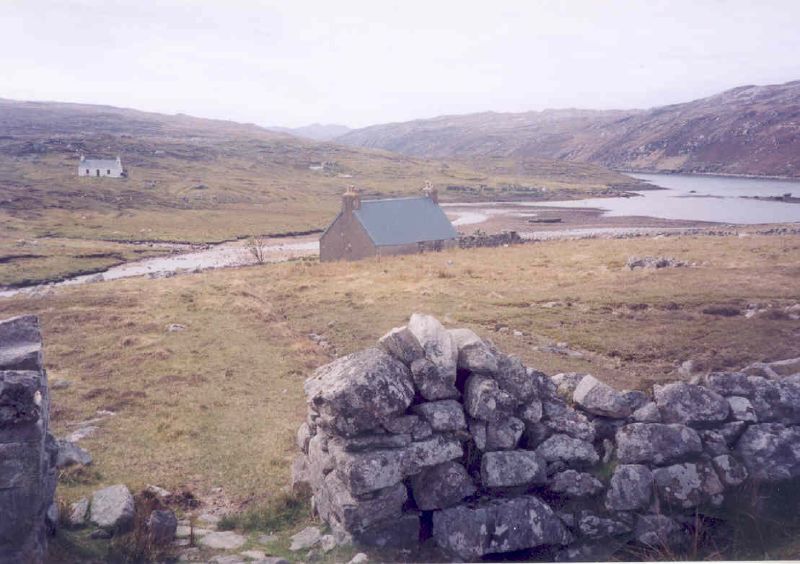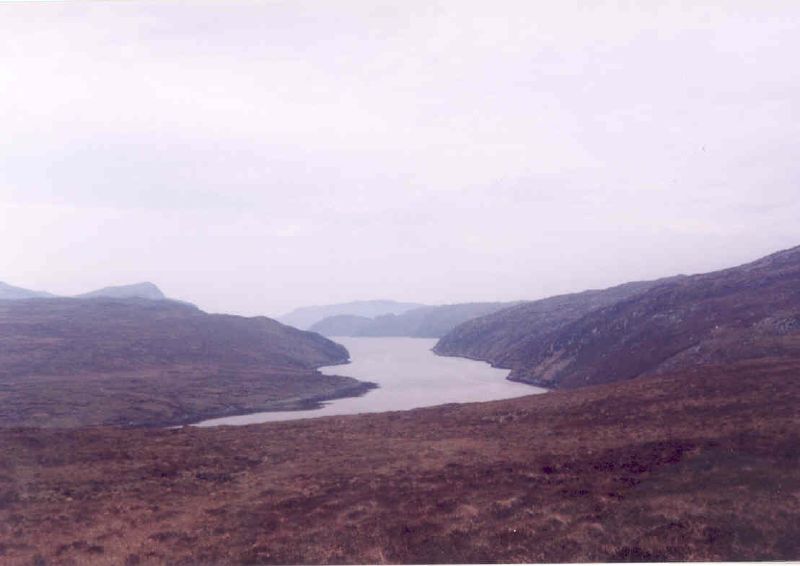At the cross-roads stood a collection of old buses, in varying stages of decay and delapidation. The main road was empty, ribboning away towards distant hills in one direction, and up a gentle incline headed north. One branch led along the shores of a sealoch, fringed by tidal mudflats and low, rocky hills. The other branch angled away steeply up the nearby hillside, then veered left towards the trapezium shape of Roineabhal. Nothing stirred.
The flock of sheep waddled its way along the rough track, up from the fank. Perched on the quad-bike, the shepherd slowly followed them behind, with his trusty collie dogs keeping the sheep under control. Roineabhal presently appeared round the corner, its dark green shape looming up against the skyline. The track skirted the hillside, towards a brief encounter with the road, before veering north into the boggy interior. The line of white signs for passing places came into alignment for a brief moment as they marched towards Roineabhal. Nothing else stirred.
It was possible to climb to the summit of Roineabhal from where the road crossed over its southern shoulder. Looking back, the lone walker could espy the distant houses in the village and the long ribbon of the sealoch disappearing towards the east. The landscape to the north was a confusion of water and land, difficult to discern where land ended and water began, or where water ended and land began. Even with a map, it could be treacherous. The walker knew that. A distant noise drew his attention. Was it traffic on the road?
The noise receded again. The wind sighed in the grasses and the rocks, feeling chilly as it was funnelled through the pass east of Roineabhal. Grey clouds slowly moved overhead as the road angled down along the slope. No traffic moved at all. Stretches of water extended this way and that, but the roadway was steadfast in its motion through the watery maze.
The hut stood forlorn at the shore of the loch, with Roineabhal towering over it. Waves lapped ashore, spurred on by the breeze. Its sign intimated that it was in use by a local fishing group, and a boat was tethered to a mouldering stake nearby. The sun peeped through the clouds, making occasional mirrors blink off the surface of the water. Water had also filled up the boat, and little ripples were blown across there too. A car was parked nearby, but appeared to have been there a long time. Its windows were steamed up, grass grew up the tyres and mould was encroaching. No tyre-tracks were visible in the sandy trail leading to the hut from the nearby road. This swept north to cross the outfalls of Loch Langabhat.
The road remained strangely empty. Its white kerblines angled up the slopes of Roineabhal, and curved sharply west across the outflows of Loch Langabhat. Another hut, lying a few hundred yards off the road, again with a derelict vehicle left outside. A deep rut led down towards the water's edge, but its swirling depths were anything but inviting for boating. The door swung open and shut on the breeze, but nothing else stirred.
After the sharp dogleg crossing the Langabhat outflow, the road smoothed into a gentle curve. The link to the Bernera road followed the Grimersta River system north, but this was soon left behind. The conical shape of Coltreasal loomed up ahead, closing off the northwestern end of Coire Geurad. Which is where a small rowing boat lay abandoned on the shore. It was ever so slightly unexpected to see smoke rising from the rudimentary dwellings higher up the hillside, not far from the roadside.
The road junction was deserted. One branch led north, towards Kinlochroag. The other angled south, within sight of another loch, with a house on the far bank. But that was of no interest. None would even think of going near it. The forbidding bulk of Scalabhal reared up in the middle distance, but the road gradually veered away from it. Upon crossing a stream, the remains of habitation could be made out. A hint of smoke seemed to curl from one roof, which had remained intact.
The rowan bent in the strong breeze, whistling up the loch. This ended where the rivers ended that voided into it. Ended too had the lives of the few houses that stood above the water's edge. Strange names, which had settled into the dust of lives left behind. The end of the road too. There had been plans to extend it further south, into Harris, but nobody felt there was much point. Nobody lived at Luachair anymore, or at Crola, or at Ceann Loch Reasort. Boarded up were what remained of windows, no longer reflecting the light of the setting sun. Only the rowan remained, the wind mournfully singing in its branches, of lives born, lived and ended there. The dark hills fringing the loch as it marched west, until Taran Mor shielded what lay beyond, the island of Scarp, and beyond that, the Atlantic. So many had crossed that water, leaving behind their old life for a new one far away. The road ended here too, 14 miles from where it had started. Leading through the empty interior of Lewis, where sometimes people lived. Oldest of all, below Scalabhal, some twenty centuries back. The shieling settlement at Coire Geurad. You'll be hard pressed to find the Road of the Rowan. It does not exist on the ground. You can go to Balallan, to the South Lochs junction - only three roads leave from there, not four. Roineabhal stands in splendid isolation, as does Loch Langabhat. No roads touch either place, nor is Coltreasal scarred by such an intrusion. The house by the loch is private beyond privacy, and only a private road leads there. The Queen's Highway does not. The Road of the Rowan can be found by those who go looking for the dwellings of old, abandoned under duress or voluntarily. It leads everywhere in the Long Island. If you know where to look.

